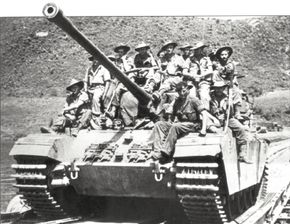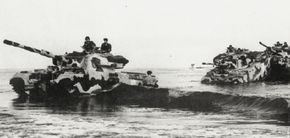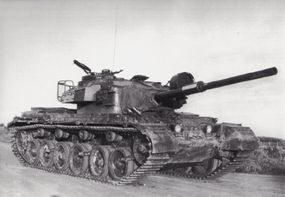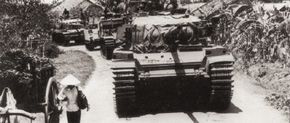The development of the Centurion Main Battle Tank began in 1943 when the British Army asked for a new cruiser tank equipped with at least a 17-pounder gun. They wanted a fast tank that, even though heavily armored, would perform well in cross-country travel.
Prototypes of the new tank, known as the A-41, were built and sent to Germany in 1945, but the war ended before they saw combat.
Advertisement
Tank Image Gallery
At first the Centurion, as the new tank was named, did not represent much, if any improvement over medium tanks then available. In fact, it compared well with the Nazi German Panzerkampfwagen V Panther, which had entered service two years earlier.
The Centurion Main Battle Tank weighed 42.5 tons, the Panther Model D, 43. It was equipped with a 17-pounder 76.5mm gun that had a muzzle velocity of 2,950 feet per second. The Panther D was armed with a 75mm gun with a muzzle velocity of 3,070 feet per second.
The Centurion was powered by a 600-horsepower Rolls Royce Merlin Meteor V-12 engine; the Panther D used a 642-horsepower V-12 Maybach engine.
Even the next-generation Centurion seemed a shadow of the Panther. When the Centurion Mark (Mk) 3 (not to be confused with either the World War I Marks or the Matildas of World War II) was developed, it was equipped with an 83.4mm, or 20-pounder, gun.
The up-rated Panther, which had design work completed but never entered production, was to be equipped with the 88mm gun used on the Tiger II. Both guns had muzzle velocities very close to 3,340 feet per second.
Even so, the Centurion 3 Main Battle Tank was the most heavily armed tank of its category in the immediate postwar years. But strangely enough, neither the tank's design nor even its gun design, was responsible for this.
The Centurion 3 fired a new round that used a narrow diameter, finned, solid steel spike, or arrow, that was wrapped in a light metal jacket to give it the same diameter as the bore. This new round was called an armor-piercing, discarding sabot (APDS) round, and it left the muzzle of the 20 pounder at 4,800 feet per second. It could penetrate twice as much armor as the 88mm gun.
The Centurion 3 Main Battle Tank was a commercial, as well as a military, success. It was adopted by Australia, Canada, India, South Africa, Sweden, Switzerland, and other nations.
The Centurion was perhaps the first tank to face itself in a shooting war. Egypt, Iraq, and Israel bought Centurions and used them against one another in the 1967 and 1973 Arab-Israeli wars. The United States purchased Centurions and gave them to Denmark and the Netherlands under the Military Aid Program.
To learn more about the Centurion Main Battle Tank's equipment, continue to the next page.
For more information about tanks and the military, see:
- Historic Tank Profiles
- How M1 Tanks Work
- How the U.S. Army Works
- How the U.S. Marines Work
Advertisement



